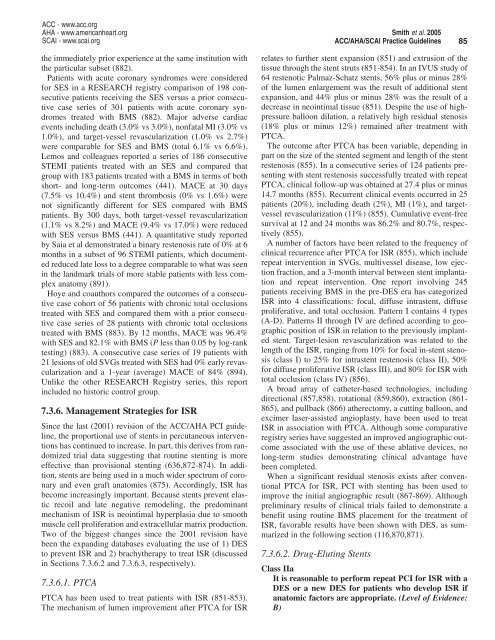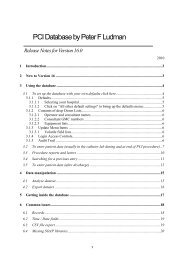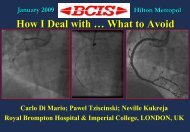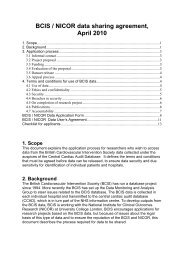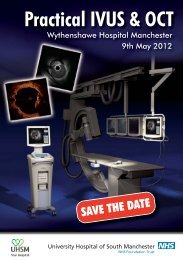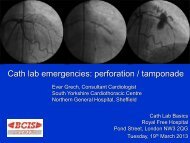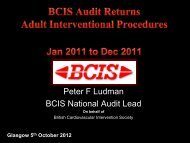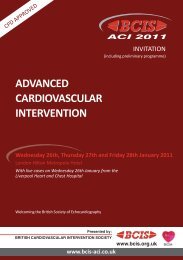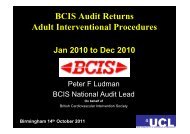Recommendations
ACC/AHA/SCAI PCI Guidelines - British Cardiovascular Intervention ...
ACC/AHA/SCAI PCI Guidelines - British Cardiovascular Intervention ...
- No tags were found...
You also want an ePaper? Increase the reach of your titles
YUMPU automatically turns print PDFs into web optimized ePapers that Google loves.
ACC - www.acc.org<br />
AHA - www.americanheart.org<br />
SCAI - www.scai.org<br />
Smith et al. 2005<br />
ACC/AHA/SCAI Practice Guidelines<br />
85<br />
the immediately prior experience at the same institution with<br />
the particular subset (882).<br />
Patients with acute coronary syndromes were considered<br />
for SES in a RESEARCH registry comparison of 198 consecutive<br />
patients receiving the SES versus a prior consecutive<br />
case series of 301 patients with acute coronary syndromes<br />
treated with BMS (882). Major adverse cardiac<br />
events including death (3.0% vs 3.0%), nonfatal MI (3.0% vs<br />
1.0%), and target-vessel revascularization (1.0% vs 2.7%)<br />
were comparable for SES and BMS (total 6.1% vs 6.6%).<br />
Lemos and colleagues reported a series of 186 consecutive<br />
STEMI patients treated with an SES and compared that<br />
group with 183 patients treated with a BMS in terms of both<br />
short- and long-term outcomes (441). MACE at 30 days<br />
(7.5% vs 10.4%) and stent thrombosis (0% vs 1.6%) were<br />
not significantly different for SES compared with BMS<br />
patients. By 300 days, both target-vessel revascularization<br />
(1.1% vs 8.2%) and MACE (9.4% vs 17.0%) were reduced<br />
with SES versus BMS (441). A quantitative study reported<br />
by Saia et al demonstrated a binary restenosis rate of 0% at 6<br />
months in a subset of 96 STEMI patients, which documented<br />
reduced late loss to a degree comparable to what was seen<br />
in the landmark trials of more stable patients with less complex<br />
anatomy (891).<br />
Hoye and coauthors compared the outcomes of a consecutive<br />
case cohort of 56 patients with chronic total occlusions<br />
treated with SES and compared them with a prior consecutive<br />
case series of 28 patients with chronic total occlusions<br />
treated with BMS (883). By 12 months, MACE was 96.4%<br />
with SES and 82.1% with BMS (P less than 0.05 by log-rank<br />
testing) (883). A consecutive case series of 19 patients with<br />
21 lesions of old SVGs treated with SES had 0% early revascularization<br />
and a 1-year (average) MACE of 84% (894).<br />
Unlike the other RESEARCH Registry series, this report<br />
included no historic control group.<br />
7.3.6. Management Strategies for ISR<br />
Since the last (2001) revision of the ACC/AHA PCI guideline,<br />
the proportional use of stents in percutaneous interventions<br />
has continued to increase. In part, this derives from randomized<br />
trial data suggesting that routine stenting is more<br />
effective than provisional stenting (636,872-874). In addition,<br />
stents are being used in a much wider spectrum of coronary<br />
and even graft anatomies (875). Accordingly, ISR has<br />
become increasingly important. Because stents prevent elastic<br />
recoil and late negative remodeling, the predominant<br />
mechanism of ISR is neointimal hyperplasia due to smooth<br />
muscle cell proliferation and extracellular matrix production.<br />
Two of the biggest changes since the 2001 revision have<br />
been the expanding databases evaluating the use of 1) DES<br />
to prevent ISR and 2) brachytherapy to treat ISR (discussed<br />
in Sections 7.3.6.2 and 7.3.6.3, respectively).<br />
7.3.6.1. PTCA<br />
PTCA has been used to treat patients with ISR (851-853).<br />
The mechanism of lumen improvement after PTCA for ISR<br />
relates to further stent expansion (851) and extrusion of the<br />
tissue through the stent struts (851-854). In an IVUS study of<br />
64 restenotic Palmaz-Schatz stents, 56% plus or minus 28%<br />
of the lumen enlargement was the result of additional stent<br />
expansion, and 44% plus or minus 28% was the result of a<br />
decrease in neointimal tissue (851). Despite the use of highpressure<br />
balloon dilation, a relatively high residual stenosis<br />
(18% plus or minus 12%) remained after treatment with<br />
PTCA.<br />
The outcome after PTCA has been variable, depending in<br />
part on the size of the stented segment and length of the stent<br />
restenosis (855). In a consecutive series of 124 patients presenting<br />
with stent restenosis successfully treated with repeat<br />
PTCA, clinical follow-up was obtained at 27.4 plus or minus<br />
14.7 months (855). Recurrent clinical events occurred in 25<br />
patients (20%), including death (2%), MI (1%), and targetvessel<br />
revascularization (11%) (855). Cumulative event-free<br />
survival at 12 and 24 months was 86.2% and 80.7%, respectively<br />
(855).<br />
A number of factors have been related to the frequency of<br />
clinical recurrence after PTCA for ISR (855), which include<br />
repeat intervention in SVGs, multivessel disease, low ejection<br />
fraction, and a 3-month interval between stent implantation<br />
and repeat intervention. One report involving 245<br />
patients receiving BMS in the pre-DES era has categorized<br />
ISR into 4 classifications: focal, diffuse intrastent, diffuse<br />
proliferative, and total occlusion. Pattern I contains 4 types<br />
(A-D). Patterns II through IV are defined according to geographic<br />
position of ISR in relation to the previously implanted<br />
stent. Target-lesion revascularization was related to the<br />
length of the ISR, ranging from 10% for focal in-stent stenosis<br />
(class I) to 25% for intrastent restenosis (class II), 50%<br />
for diffuse proliferative ISR (class III), and 80% for ISR with<br />
total occlusion (class IV) (856).<br />
A broad array of catheter-based technologies, including<br />
directional (857,858), rotational (859,860), extraction (861-<br />
865), and pullback (866) atherectomy, a cutting balloon, and<br />
excimer laser-assisted angioplasty, have been used to treat<br />
ISR in association with PTCA. Although some comparative<br />
registry series have suggested an improved angiographic outcome<br />
associated with the use of these ablative devices, no<br />
long-term studies demonstrating clinical advantage have<br />
been completed.<br />
When a significant residual stenosis exists after conventional<br />
PTCA for ISR, PCI with stenting has been used to<br />
improve the initial angiographic result (867-869). Although<br />
preliminary results of clinical trials failed to demonstrate a<br />
benefit using routine BMS placement for the treatment of<br />
ISR, favorable results have been shown with DES, as summarized<br />
in the following section (116,870,871).<br />
7.3.6.2. Drug-Eluting Stents<br />
Class IIa<br />
It is reasonable to perform repeat PCI for ISR with a<br />
DES or a new DES for patients who develop ISR if<br />
anatomic factors are appropriate. (Level of Evidence:<br />
B)


